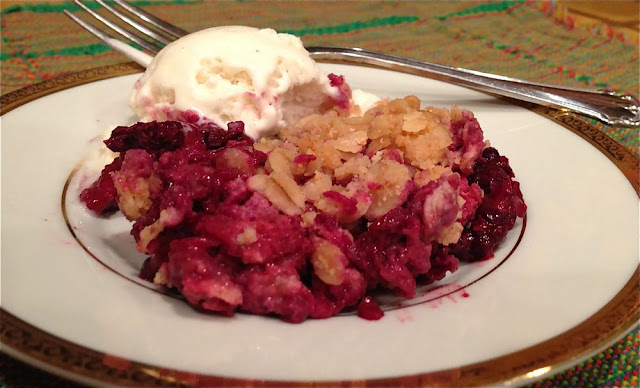Revised August 23, 2015
Email subscribers, please click on the blog title to get to the website where photos look better and text is easier to read.
Email subscribers, please click on the blog title to get to the website where photos look better and text is easier to read.
 |
| Most everything you need for eggplant Parmesan is right here. Jalapenos optional. |
 |
This time of year all our dinners look the same—red and green—mostly red. That's because of tomato bounty, tomato beauty, and so many greens and eggplants and onions and garlic and basil and on and on. Truly an embarrassment of dishes/riches from kitchen bitches. Of which I am apparently one. I'm a little bossy about diet and cooking. An eggplant Parmesan recipe follows, pictures first. This year I have had to beg or buy eggplants as we had a mysterious eggplant crop failure.
|
Eggplant Parmesan is so much easier when you skip the salting-the-sliced-eggplant-then-rinsing-and-drying steps and also the dredging-in- flour-or-crumbs part. I omitted the flour/crumbs step because of my carb-avoidance behavior, but discovered that dipping the slices in a beaten egg and frying in olive oil is just as good, if not better, than the carb-dredging routine. Oh joy! I left out the salting part when I was in a big rush and discovered THAT doesn't matter either. So right there you lop off another 15 or 20 minutes.
I am sticking with the no-salting method. Anything that saves prep time is good, especially when you can't tell the difference with the finished product.
 |
| Layered egg-batter fried eggplant. Full recipe below. |
 |
More layering. Did we talk about the homemade marinara sauce? Only if you have time and tomatoes to spare.
|
Eggplant Parmesan
Let's make some assumptions. You have fresh tomatoes and nice firm glossy eggplants. You have time. (The biggest assumption of all.) But listen. If you don't have time to make your own marinara from fresh tomatoes, but still want to make a fabulous eggplant Parmesan, buy a good marinara sauce and pump it up with garlic, a little pesto, some pepper flakes, and your desire to make yourself and others glow at the dinner table.Do what you can do. Good cheese helps no matter what.
This makes enough for 6-8 servings in a 9X13 inch pan. It freezes well, and keeps for several days refrigerated.
Ingredients
2-3 medium to large fresh eggplants
1.5 to 2 quarts marinara sauce, more or less, homemade preferable
8 - 10 ounces grated Parmesan cheese
12-16 ounces shredded mozzarella, jack, cheddar cheeses, mixed
salt and pepper to taste
salt for treating eggplant slices
2-3 medium eggs
2-4 Tbsp olive oil
1 cup thinly sliced sweet red pepper or jalapeno pepper or combination—deluxe version
1 cup thinly sliced sweet onion—deluxe version.
Directions
1. Slice the eggplants into 1/2 - 3/4 inch rounds.
2. Beat the eggs in a small bowl. In the meantime, heat half the olive oil over medium heat in a non-stick pan. When the oil is hot, but not smoking, coat the eggplant slices in beaten eggs and fry in olive oil until lightly browned on both sides. Add more oil as necessary. (May be more than 4 tablespoons.) Set aside fried eggplant slices on a grate to cool. Blot with paper towels, if you're weird about oil. If you have leftover egg, fry quickly, chop, and add to casserole. It's a sin to waste food.
3. When all eggplant slices are fried, spoon a layer of marinara on the bottom of your casserole dish. Add a layer of eggplant, sprinkle with cheeses.
4. If you're using sliced sweet onions and/or peppers, spread some atop the cheeses
.
5. Add another layer of eggplant topped by more "deluxe" items, if using, then cover with marinara.
If you have leftover eggplant slices, place a piece of waxed paper between slices and freeze for later use.
Pop uncovered into preheated 350 degree oven. Bake for 35 - 45
minutes, or whenever sauce is bubbling around the edges. Remove from oven and apply the final layer of mixed cheeses plus a few fresh pepper/onions, if you like. Return to oven and turn off the heat. Allow the cheese to melt for five to seven minutes. Remove from oven and let it rest for about 10 minutes before serving.
Low-carb notes
Eggplant is low-carb to the max. One medium unpeeled eggplant has about 13 grams of carbs plus 19 grams of fiber. Which, with fiber grams subtracted, is a minus-carb count.
Peppers are also very low in carbs, but onions are not, and fresh tomatoes, depending upon sugar content, may be high in carbs. However, they also have a lot of fiber, especially if you follow my directions for using the entire tomato, skins included, to make homemade marinara.
Do you know about subtracting the fiber content from carb content to figure out how many carbs you're consuming? Example: a half cup of chopped raw tomato has 4.2 grams of carbs and 1 gram of fiber. Subtract the fiber gram and you get carb 3.2 grams. (The Complete Book of Food Counts by Corinne T. Netzer)
People who are serious about losing weight with low-carb diets count every carb and most try to keep their carb consumption at 30 per day or fewer. That's roughly the equivalent of two thin slices of bread, One large baked potato with skin has about 50 carbs and just 4.8 grams fiber. You could run on that thing for two days! Except that after eating that many unbuffered-by-fiber carbs, you're likely to feel hungry a couple hours after eating.

















































